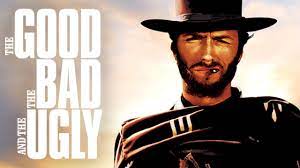"The Good, the Bad and the Ugly" is a classic Western film directed by Sergio Leone and released in 1966. It is widely regarded as one of the greatest Westerns ever made and has become an iconic piece of popular culture. The movie stars Clint Eastwood as "The Good," Lee Van Cleef as "The Bad," and Eli Wallach as "The Ugly." The three actors give outstanding performances, and the film's memorable score, composed by Ennio Morricone, adds to its enduring appeal.
The movie is set during the American Civil War and follows three gunslingers as they search for a buried treasure of gold. The film is a masterclass in tension-building and suspense, as the three characters engage in a series of betrayals and double-crosses in their quest for the treasure. The movie's extended and atmospheric scenes, punctuated by gunfire and Morricone's haunting score, create a sense of unease and danger that persists throughout the film.
One of the film's most famous scenes is the standoff between the three characters in a cemetery. The scene is iconic for its use of close-ups and extreme long shots to build tension. As the camera moves between the characters, the music builds to a crescendo, heightening the tension until the inevitable shootout occurs. The scene is a masterclass in filmmaking, and its impact can still be felt in modern cinema.
Another memorable scene is the torture scene, in which Tuco (Eli Wallach) is forced to walk through the desert with no water. The scene is shot in extreme close-up, and the viewer is forced to confront the agony and desperation of Tuco as he crawls through the sand. The scene is a powerful indictment of the brutality of the Western genre, and Leone's willingness to confront such themes helped to elevate the film above its contemporaries.
The movie's final scene, in which the three characters engage in a final shootout over the gold, is another classic moment in cinema. The scene is shot in extreme close-up, with the camera focusing on the characters' eyes and hands as they prepare to draw their weapons. The tension builds to a fever pitch, and the eventual shootout is a satisfying conclusion to the film's many conflicts.
“The Good, the Bad and the Ugly" has had a significant impact on cinema, and its influence can be seen in countless films that followed. Here are a few examples of movies that have borrowed from or been inspired by elements of "The Good, the Bad and the Ugly:"
1. "Kill Bill: Vol. 2" (2004) - Quentin Tarantino's homage to the Spaghetti Western genre borrows heavily from "The Good, the Bad and the Ugly." The final duel between Beatrix Kiddo (Uma Thurman) and Bill (David Carradine) takes place in a remote desert location, reminiscent of the film's climactic shootout. Additionally, the film's score by RZA has been compared to Morricone's iconic music.
2. "Django Unchained" (2012) - Another Tarantino film that draws inspiration from "The Good, the Bad and the Ugly," "Django Unchained" features a climactic shootout in a cemetery that is reminiscent of the film's famous standoff. The film's score, by Morricone himself, also echoes the music of his earlier work.
3. "The Dark Knight" (2008) - Christopher Nolan's Batman film features a scene in which The Joker (Heath Ledger) confronts Harvey Dent (Aaron Eckhart) in a hospital. The tension and sense of unease in the scene are similar to the buildup in the cemetery standoff in "The Good, the Bad and the Ugly."
4. "No Country for Old Men" (2007) - Directed by the Coen Brothers, this neo-Western shares many of the same themes and motifs as "The Good, the Bad and the Ugly." Like the earlier film, "No Country for Old Men" features a tense standoff between its main characters, and both films explore the brutal violence and lawlessness of the American…

QzeoqFfW
OKiMnjuoR